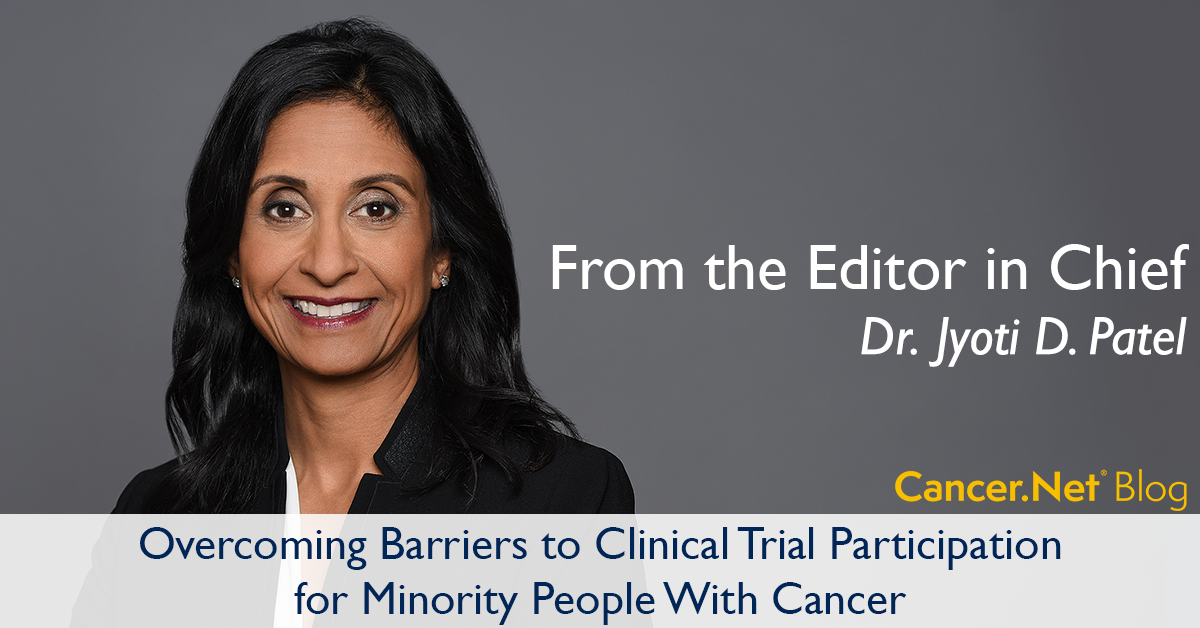
Clinical trials are the main way scientists and health care providers develop new and improved cancer treatments. Data from clinical trials on a treatment’s safety and effectiveness provide insights about how the medications can be used best. However, differences between people can often lead to different responses and side effects from these treatments. For example, age, genetics, gender, weight, ethnic origin, and even geographic location can all play a role in how a treatment works or how safe it may be.
There was a time when most clinical trials only included white males. In fact, in some early lung cancer screening trials, for instance, only men were eligible. Now we know that women who are at increased risk for lung cancer may gain the greatest benefit from computed tomography (CT) scan screening! In an effort to better understand different interventions in diverse populations, the National Institutes of Health adopted a policy in 1993 requiring that all federal grants for clinical research include women and minorities. Despite these policies, significant disparities still exist between participants represented in clinical trials and those actually experiencing cancer.
In the United States, less than 5% of adults with cancer choose to participate in clinical trials. And although minority racial and ethnic groups make up nearly 40% of the American population, only 11% of the 4,922 participants in the clinical trials of 18 new cancer drugs approved in 2020 by the U.S. Food and Drug Administration (FDA) were Black or Hispanic. Moreover, in some cancers, their clinical trial representation remains very low, even though these groups are more likely to be affected by a specific diagnosis. For example, African Americans are 2 to 3 times more likely to be affected by multiple myeloma and often present at a younger age with more aggressive disease. Studies in multiple myeloma therefore should include many more Black participants. These disparities in clinical trial participation among different groups of Americans could be one of the reasons why we witness different outcomes between Black and white people with cancer.
To ensure that the newest options for cancer prevention, screening, and treatment benefit all people with cancer, health systems and cancer care providers must do everything possible to make clinical trials accessible. So, what are the barriers that we need to overcome?
1: Not finding out about clinical trial opportunities
Some people of color don’t find out about clinical trial opportunities because their doctors don’t present them as an option, for any number of reasons. This can be a major barrier, as many people don’t know how to ask about, learn about, or find clinical trials on their own without a doctor’s support.
2: Logistical challenges of clinical trials
Participating in a clinical trial can take extra time and may require more visits to the hospital or clinic. Often the person with cancer may have multiple other roles, such as parenting or being the source of income for their family. Managing to meet the availability for clinical trial procedures, planning transportation to the clinic site, arranging childcare, and taking time away from work are all substantial burdens. However, doing some study procedures at sites closer to home, considering evening and weekend schedules, and working with clinical trial sponsors to pay for parking and travel costs may help lessen this burden.
3: Overly strict eligibility criteria of clinical trials
Every clinical trial has guidelines about who is eligible to join the trial. These eligibility criteria are meant to protect the safety of study participants and ensure that they share certain characteristics. Sometimes, however, overly strict criteria have prevented many people from being able to enroll in clinical trials. Some examples of these criteria exclude people who have brain metastases or poor kidney function. Other participants are excluded from clinical trials because of diseases that disproportionately affect people of color, such as high blood pressure, diabetes, or hepatitis. Researchers are trying to pay closer attention to whether the eligibility criteria for each clinical trial makes sense scientifically.
4: Fear and mistrust of clinical trials
Some people don’t trust that clinical trials are conducted in a safe way. People of color, in particular, may simply lack trust in the health care system. They may have personally experienced or observed discrimination in a health care setting. Or, they may have not previously received standard of care treatments. For example, research shows that Black and Hispanic women are less likely than white women to receive recommended breast cancer treatments. Language barriers can also lead to fear and distrust and, despite using a translator, may prevent discussions around the benefits or risks of clinical trial participation.
It is important that we share information about clinical trial disparities and the progress made in addressing these disparities in an honest and authentic way with communities. Then, people who have traditionally been excluded from clinical trials can begin to see the benefits of participation—for themselves and for future generations.







